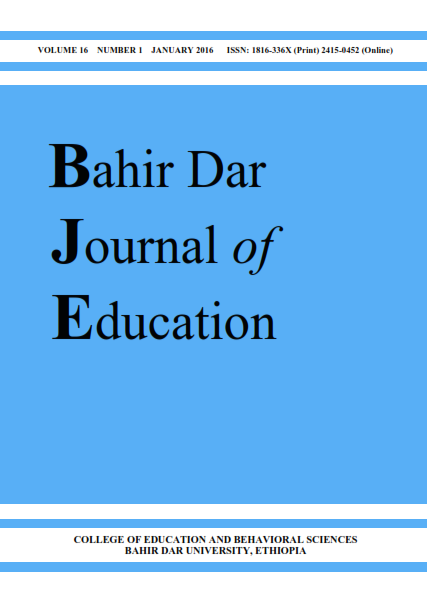Visually Impaired Children in some sites of Ethiopia: Review on Prevalence, Causes and Problems
Abstract
This paper is a review of literature on the prevalence and causes of visual impairment as well as problems children with visual impairment are facing in Ethiopia. The purpose of the review was to examine the causes of child visual impairment and the problems visually impaired children are experiencing. Thirteen studies which were conducted in Ethiopia between the years 2000 and 2014 on visual impairment of children below the age of 16 were included in the review. The review indicated that while the frequently mentioned causes of complete blindness reported in the studies are cataract and corneal scarring, that of visual impairment (low vision and blindness) are trachoma and refractive error. With little difference, the synthesized data identified corneal scarring as the leading cause to blindness and trachoma to visual impairment (low vision and blindness). The review also indicated visually impaired children live with multifaceted social, psychological and educational problems. Finally, it is concluded that working on enhancement of the prevention practice of trachoma and corneal scarring and solving the problems of visually impaired children need critical attention.References
Aga, A. (2007). Evaluation of the safe strategy for preventing trachomatous visual impairment in the Enemor and Ener district of Ethiopia. Community Eye Health, 20(61), 13-14
Demissie, B.S., & Solomon, A.W. (2011). Magnitude and causes of childhood blindness and severe visual impairment in Sekoru District, Southwest Ethiopia: A survey using the key informant method. Transactions of the Royal Society of Tropical Medicine and Hygine, 105(9), 507-511.
Eyob L. (2001). Prevalence and risk factors among children of WoreIlu Woreda South Wolo Administrative Zone. Ethiopian Journal of Health Sciences, 11(1), 27-36
Hailie W., & Destaye S. (2013). Prevalence and associated factor of visual impairment and blindness at university of Gonder Technical hospital, Gonder North West Ethiopia. International Journal of Pharmaceuticals and Health Care Research, l03 (2), 48-54
Heward ,W.L. (2006). Exceptional Children: An Introduction to Special Education ( 8 ed). Upper Saddle River : Pearson Merrill Printice Hall.
Heward, W. L., & Orlansky, M. D. (1988). Exceptional Children (3 rd ed). Columbus: Mrrill Publishing Company
Kassie, S. (2013). Inclusive teaching involving visually impaired students in English language teaching (ELT) setting. Unpublished doctoral dissertation, Andhra University, India.
Kello, A. B., & Gilbert, C. (2003). Causes of severe impairment and blindness in children in schools for the blind in Ethiopia. British Journal of Ophthalmology, 87(5), 526-530.
Medical dictionary (2003-2016). Visual Impairment. Retrieved from http://medicaldictionary.thefreedictionary.com/Visual+Impairment
Ministry of Education (MoE) (2006). Special needs education program strategy. Emphasizing inclusive education to meet the UPEC and EFA goals. Addis Ababa
Mohammed, S., & Abebe, B. (2005).Common eye diseases in children of rural community in Goro district, central Ethiopia. Ethiopian Journal of Health Development, 19(2):148152
Salvin, J. H. (2013). Visual impairment. Retrieved from http://kidshealth.org/teen/diseases_conditions/sight/visual_impairment.html#
Shonkoff , J.P. & Marshall, P.C. (2009). The biology of developmental vulnerability. Handbook of Early Child Hood Intervention (2 nd ed). Cambridge: Cambridge University Press.
Tabin, G. C., & Kelley, K. H. (2007). Visual Impairment. Retrieved from https://www.cugh.org/sites/default/files/78_Visual_Impairment_FINAL.pdf
Tamru, E. B. (2005). African perspective on visual impairments: ICT’s and policies: A personal experience, a variety of perspectives and technological solution. Retrieved from http://www3.Sympatico.Ca/Tamru
Tibebu, K., & Getu, D. A. (2000). Prevalence of refractive errors in preschool and school children Debark and Koladiba towns, North Western Ethiopia. Ethiopian Journal of Health Development, 17(12), 117-124
Tirusew, T., Savlainen, H., Agdew, R., & Desta, D. (1995). Baseline survey on disabilities in Ethiopia. Addis Ababa University: Addis Ababa Commercial Printing Enterprise
Wondu ,A. & Samson, B.(2005). Eye disease and blindness. Epidemiology And Ecology of Health And Disease in Ethiopia. Addis Ababa: Shama Books.
World Health Organization (WHO) (2009). Visual impairment and blindness. Retrieved From http://www.who.int/mediacentre/factsheets/fs282/en/
WHO (2010). Global data on visual impairment. Retrieved From www.who.int/about/licensing/copyright_form/en/index.html
WHO (2011). International statistical classification of diseases and related health problems. Retrieved From http://www.who.int/classifications/icd/en/
Yemane, B., Alemayehu, W., & Abebe B. (2006). National survey on blindness, low vision and trachoma in Ethiopia. Retrieved from http// www.trachoma.org/tmatters/itin4.pdf
Yemane, B., Alemayehu, W., Abebe, B., Liknaw, A., Wondu, A., Amir, B., Sheila, W. (2007). Prevalence of trachoma in Ethiopia. Ethiopian Journal of Health, 21(3), 211215
Zelalem, A., (2014). Pattern of childhood ocular morbidity in rural eye hospital, central Ethiopia. BMC Ophthalmol Retrieved from http://www.biomedcentral.com/14712415/14/50
Authors who publish with this journal agree to the following terms:
- Authors retain copyright and grant the journal right of first publication with the work simultaneously licensed under a Creative Commons Attribution License that allows others to share the work with an acknowledgement of the work's authorship and initial publication in this journal.
- Authors are able to enter into separate, additional contractual arrangements for the non-exclusive distribution of the journal's published version of the work (e.g., post it to an institutional repository or publish it in a book), with an acknowledgement of its initial publication in this journal.
- Authors are permitted and encouraged to post their work online (e.g., in institutional repositories or on their website) prior to and during the submission process, as it can lead to productive exchanges, as well as earlier and greater citation of published work (See The Effect of Open Access).

